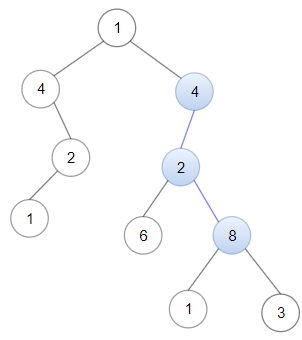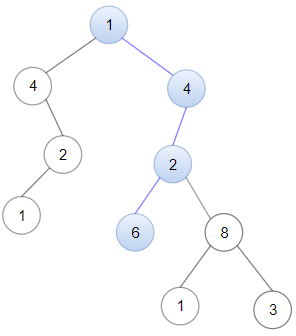树
深度优先搜索
广度优先搜索
链表
二叉树
题目描述
给你一棵以 root 为根的二叉树和一个 head 为第一个节点的链表。
如果在二叉树中,存在一条一直向下的路径,且每个点的数值恰好一一对应以 head 为首的链表中每个节点的值,那么请你返回 True ,否则返回 False 。
一直向下的路径的意思是:从树中某个节点开始,一直连续向下的路径。
示例 1:
输入: head = [4,2,8], root = [1,4,4,null,2,2,null,1,null,6,8,null,null,null,null,1,3]
输出: true
解释: 树中蓝色的节点构成了与链表对应的子路径。
示例 2:
输入: head = [1,4,2,6], root = [1,4,4,null,2,2,null,1,null,6,8,null,null,null,null,1,3]
输出: true
示例 3:
输入: head = [1,4,2,6,8], root = [1,4,4,null,2,2,null,1,null,6,8,null,null,null,null,1,3]
输出: false
解释: 二叉树中不存在一一对应链表的路径。
提示:
二叉树和链表中的每个节点的值都满足 1 <= node.val <= 100 。
链表包含的节点数目在 1 到 100 之间。
二叉树包含的节点数目在 1 到 2500 之间。
解法
方法一:递归
我们设计一个递归函数 $dfs(head, root)$,表示链表 $head$ 是否是以 $root$ 为起点的路径上的节点值一一对应的子路径。函数 $dfs(head, root)$ 的逻辑如下:
如果链表 $head$ 为空,说明链表已经遍历完了,返回 true;
如果二叉树 $root$ 为空,说明二叉树已经遍历完了,但链表还没遍历完,返回 false;
如果二叉树 $root$ 的值与链表 $head$ 的值不相等,返回 false;
否则,返回 $dfs(head.next, root.left)$ 或 $dfs(head.next, root.right)$。
我们在主函数中,对二叉树的每个节点调用 $dfs(head, root)$,只要有一个返回 true,就说明链表是二叉树的子路径,返回 true;如果所有节点都返回 false,说明链表不是二叉树的子路径,返回 false。
时间复杂度 $O(n^2),空间复杂度 O(n)$。其中 $n$ 是二叉树的节点数。
Python3 Java C++ Go TypeScript Rust
1
2
3
4
5
6
7
8
9
10
11
12
13
14
15
16
17
18
19
20
21
22
23
24
25
26
27 # Definition for singly-linked list.
# class ListNode:
# def __init__(self, val=0, next=None):
# self.val = val
# self.next = next
# Definition for a binary tree node.
# class TreeNode:
# def __init__(self, val=0, left=None, right=None):
# self.val = val
# self.left = left
# self.right = right
class Solution :
def isSubPath ( self , head : Optional [ ListNode ], root : Optional [ TreeNode ]) -> bool :
def dfs ( head , root ):
if head is None :
return True
if root is None or root . val != head . val :
return False
return dfs ( head . next , root . left ) or dfs ( head . next , root . right )
if root is None :
return False
return (
dfs ( head , root )
or self . isSubPath ( head , root . left )
or self . isSubPath ( head , root . right )
)
1
2
3
4
5
6
7
8
9
10
11
12
13
14
15
16
17
18
19
20
21
22
23
24
25
26
27
28
29
30
31
32
33
34
35
36
37
38
39
40
41
42
43 /**
* Definition for singly-linked list.
* public class ListNode {
* int val;
* ListNode next;
* ListNode() {}
* ListNode(int val) { this.val = val; }
* ListNode(int val, ListNode next) { this.val = val; this.next = next; }
* }
*/
/**
* Definition for a binary tree node.
* public class TreeNode {
* int val;
* TreeNode left;
* TreeNode right;
* TreeNode() {}
* TreeNode(int val) { this.val = val; }
* TreeNode(int val, TreeNode left, TreeNode right) {
* this.val = val;
* this.left = left;
* this.right = right;
* }
* }
*/
class Solution {
public boolean isSubPath ( ListNode head , TreeNode root ) {
if ( root == null ) {
return false ;
}
return dfs ( head , root ) || isSubPath ( head , root . left ) || isSubPath ( head , root . right );
}
private boolean dfs ( ListNode head , TreeNode root ) {
if ( head == null ) {
return true ;
}
if ( root == null || head . val != root . val ) {
return false ;
}
return dfs ( head . next , root . left ) || dfs ( head . next , root . right );
}
}
1
2
3
4
5
6
7
8
9
10
11
12
13
14
15
16
17
18
19
20
21
22
23
24
25
26
27
28
29
30
31
32
33
34
35
36
37
38
39
40 /**
* Definition for singly-linked list.
* struct ListNode {
* int val;
* ListNode *next;
* ListNode() : val(0), next(nullptr) {}
* ListNode(int x) : val(x), next(nullptr) {}
* ListNode(int x, ListNode *next) : val(x), next(next) {}
* };
*/
/**
* Definition for a binary tree node.
* struct TreeNode {
* int val;
* TreeNode *left;
* TreeNode *right;
* TreeNode() : val(0), left(nullptr), right(nullptr) {}
* TreeNode(int x) : val(x), left(nullptr), right(nullptr) {}
* TreeNode(int x, TreeNode *left, TreeNode *right) : val(x), left(left), right(right) {}
* };
*/
class Solution {
public :
bool isSubPath ( ListNode * head , TreeNode * root ) {
if ( ! root ) {
return false ;
}
return dfs ( head , root ) || isSubPath ( head , root -> left ) || isSubPath ( head , root -> right );
}
bool dfs ( ListNode * head , TreeNode * root ) {
if ( ! head ) {
return true ;
}
if ( ! root || head -> val != root -> val ) {
return false ;
}
return dfs ( head -> next , root -> left ) || dfs ( head -> next , root -> right );
}
};
1
2
3
4
5
6
7
8
9
10
11
12
13
14
15
16
17
18
19
20
21
22
23
24
25
26
27
28
29
30
31 /**
* Definition for singly-linked list.
* type ListNode struct {
* Val int
* Next *ListNode
* }
*/
/**
* Definition for a binary tree node.
* type TreeNode struct {
* Val int
* Left *TreeNode
* Right *TreeNode
* }
*/
func isSubPath ( head * ListNode , root * TreeNode ) bool {
if root == nil {
return false
}
return dfs ( head , root ) || isSubPath ( head , root . Left ) || isSubPath ( head , root . Right )
}
func dfs ( head * ListNode , root * TreeNode ) bool {
if head == nil {
return true
}
if root == nil || head . Val != root . Val {
return false
}
return dfs ( head . Next , root . Left ) || dfs ( head . Next , root . Right )
}
1
2
3
4
5
6
7
8
9
10
11
12
13
14
15
16
17
18
19
20
21
22
23
24
25
26
27
28
29
30
31
32
33
34
35
36
37
38
39
40
41
42 /**
* Definition for singly-linked list.
* class ListNode {
* val: number
* next: ListNode | null
* constructor(val?: number, next?: ListNode | null) {
* this.val = (val===undefined ? 0 : val)
* this.next = (next===undefined ? null : next)
* }
* }
*/
/**
* Definition for a binary tree node.
* class TreeNode {
* val: number
* left: TreeNode | null
* right: TreeNode | null
* constructor(val?: number, left?: TreeNode | null, right?: TreeNode | null) {
* this.val = (val===undefined ? 0 : val)
* this.left = (left===undefined ? null : left)
* this.right = (right===undefined ? null : right)
* }
* }
*/
const dfs = ( head : ListNode | null , root : TreeNode | null ) => {
if ( head == null ) {
return true ;
}
if ( root == null || head . val !== root . val ) {
return false ;
}
return dfs ( head . next , root . left ) || dfs ( head . next , root . right );
};
function isSubPath ( head : ListNode | null , root : TreeNode | null ) : boolean {
if ( root == null ) {
return false ;
}
return dfs ( head , root ) || isSubPath ( head , root . left ) || isSubPath ( head , root . right );
}
1
2
3
4
5
6
7
8
9
10
11
12
13
14
15
16
17
18
19
20
21
22
23
24
25
26
27
28
29
30
31
32
33
34
35
36
37
38
39
40
41
42
43
44
45
46
47
48
49
50
51
52
53
54
55
56
57
58
59
60
61
62
63
64
65
66 // Definition for singly-linked list.
// #[derive(PartialEq, Eq, Clone, Debug)]
// pub struct ListNode {
// pub val: i32,
// pub next: Option<Box<ListNode>>
// }
//
// impl ListNode {
// #[inline]
// fn new(val: i32) -> Self {
// ListNode {
// next: None,
// val
// }
// }
// }
// Definition for a binary tree node.
// #[derive(Debug, PartialEq, Eq)]
// pub struct TreeNode {
// pub val: i32,
// pub left: Option<Rc<RefCell<TreeNode>>>,
// pub right: Option<Rc<RefCell<TreeNode>>>,
// }
//
// impl TreeNode {
// #[inline]
// pub fn new(val: i32) -> Self {
// TreeNode {
// val,
// left: None,
// right: None
// }
// }
// }
use std :: rc :: Rc ;
use std :: cell :: RefCell ;
impl Solution {
fn dfs ( head : & Option < Box < ListNode >> , root : & Option < Rc < RefCell < TreeNode >>> ) -> bool {
if head . is_none () {
return true ;
}
if root . is_none () {
return false ;
}
let node = head . as_ref (). unwrap ();
let root = root . as_ref (). unwrap (). borrow ();
if node . val != root . val {
return false ;
}
Self :: dfs ( & node . next , & root . left ) || Self :: dfs ( & node . next , & root . right )
}
fn my_is_sub_path ( head : & Option < Box < ListNode >> , root : & Option < Rc < RefCell < TreeNode >>> ) -> bool {
if root . is_none () {
return false ;
}
let node = root . as_ref (). unwrap (). borrow ();
Self :: dfs ( head , root ) ||
Self :: my_is_sub_path ( head , & node . left ) ||
Self :: my_is_sub_path ( head , & node . right )
}
pub fn is_sub_path ( head : Option < Box < ListNode >> , root : Option < Rc < RefCell < TreeNode >>> ) -> bool {
Self :: my_is_sub_path ( & head , & root )
}
}




